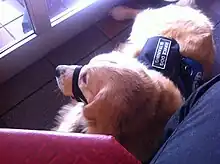

A seizure response dog (SRD) (also known as seizure dog) is a dog demonstrating specific assisting behaviour during or immediately after a person's epileptic seizure or other seizure.[1][2] When reliably trained such dogs can serve as service dogs for people with epilepsy.[3]
Tasks
Tasks for seizure dogs may include, but are not limited to:[4][5][6][7]
- Find someone to help
- Activate an emergency response system
- Stimulate a person to help them "wake up" after a seizure
- Use body weight to keep the person in a specific position
- Act as a brace to help the person up
- Retrieve a phone or medication
- Physically remove the patient from an unsafe situation (e.g., the middle of a street)
Seizure alert dog
A dog demonstrating specific behaviour prior to a person's epileptic seizure is also referred to as seizure alert dog (SAD).[2][8][9] Reports suggest that some dogs can be trained to anticipate epileptic seizures.[3][8] However, this ability has been questioned.[10][11][12]
Seizure response and seizure alerting behaviour may spontaneously develop in dogs living with children and adults with epilepsy.[1][2][9]
See also
- Working dog
- Working animal – Domesticated animals for assisting people
References
- 1 2 Di Vito L1, Naldi I, Mostacci B, Licchetta L, Bisulli F, Tinuper P (2010). "A seizure response dog: video recording of reacting behaviour during repetitive prolonged seizures". Epileptic Disord. 12 (2): 142–5. doi:10.1684/epd.2010.0313. PMID 20472528. S2CID 3337471.
{{cite journal}}: CS1 maint: multiple names: authors list (link) CS1 maint: numeric names: authors list (link) - 1 2 3 Kirton A1, Wirrell E, Zhang J, Hamiwka L (2004). "Seizure-alerting and -response behaviors in dogs living with epileptic children". Neurology. 62 (12): 2303–5. doi:10.1212/wnl.62.12.2303. PMID 15210902. S2CID 9842443.
{{cite journal}}: CS1 maint: multiple names: authors list (link) CS1 maint: numeric names: authors list (link) - 1 2 Kirton A1, Winter A, Wirrell E, Snead OC (2008). "Seizure response dogs: evaluation of a formal training program". Epilepsy Behav. 13 (3): 499–504. doi:10.1016/j.yebeh.2008.05.011. PMID 18595778. S2CID 27549519.
{{cite journal}}: CS1 maint: multiple names: authors list (link) CS1 maint: numeric names: authors list (link) - ↑ "Seizure Dogs". Paws With A Cause. Archived from the original on 2014-09-16. Retrieved 2014-10-01.
- ↑ "Seizure Service Dogs". Pawsitivity. Retrieved 2021-04-26.
- ↑ "Seizure response dogs with special training". Canine Assistants. Retrieved 2014-10-01.
- ↑ "Seizure Dogs". Epilepsy foundation. Retrieved 2014-10-01.
- 1 2 Strong V; Brown S; Walker R (1999). "Seizure-alert dogs--fact or fiction?". Seizure. 8 (1): 62–5. doi:10.1053/seiz.1998.0250. PMID 10091851.
- 1 2 Dalziel DJ1, Uthman BM, Mcgorray SP, Reep RL (2003). "Seizure-alert dogs: a review and preliminary study". Seizure. 12 (2): 115–20. doi:10.1016/S105913110200225X. PMID 12566236.
{{cite journal}}: CS1 maint: multiple names: authors list (link) CS1 maint: numeric names: authors list (link) - ↑ Doherty, MJ; Haltiner, AM (Jan 23, 2007). "Wag the dog: skepticism on seizure alert canines". Neurology. 68 (4): 309. doi:10.1212/01.wnl.0000252369.82956.a3. PMID 17242343. S2CID 33328776.
- ↑ Ortiz R; Liporace J (2005). "Seizure-alert dogs: observations from an inpatient video/EEG unit". Epilepsy Behav. 6 (4): 620–622. doi:10.1016/j.yebeh.2005.02.012. PMID 15907758. S2CID 45676449.
- ↑ Krauss GL; Choi JS; Lesser RP (2007). "Pseudoseizure dogs". Neurology. 68 (4): 308–309. doi:10.1212/01.wnl.0000250345.23677.6b. PMID 17242342. S2CID 5294710.
External links
- Seizure-alert dogs National Geographic News article
- Canine Assistants Service Dog School - Specializing in the placement of Seizure Response dogs, and seizure scent research